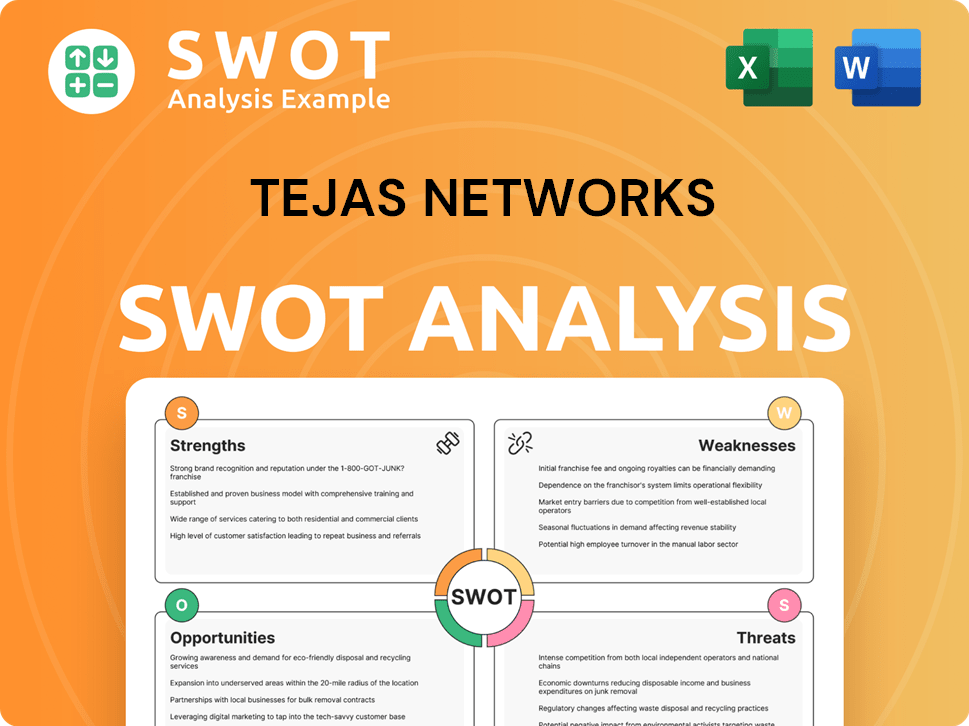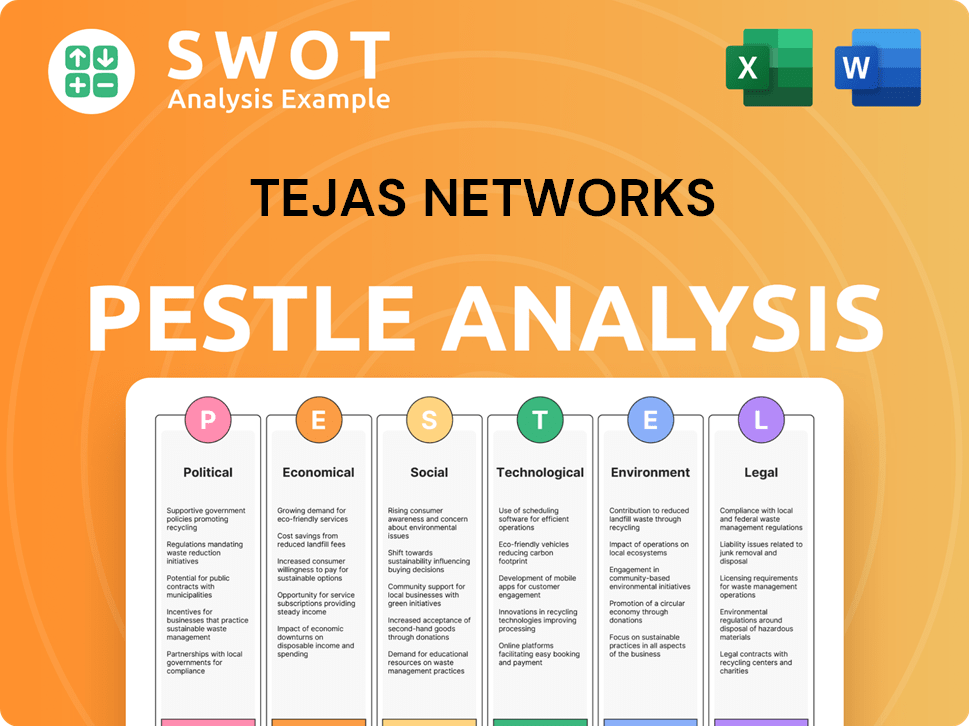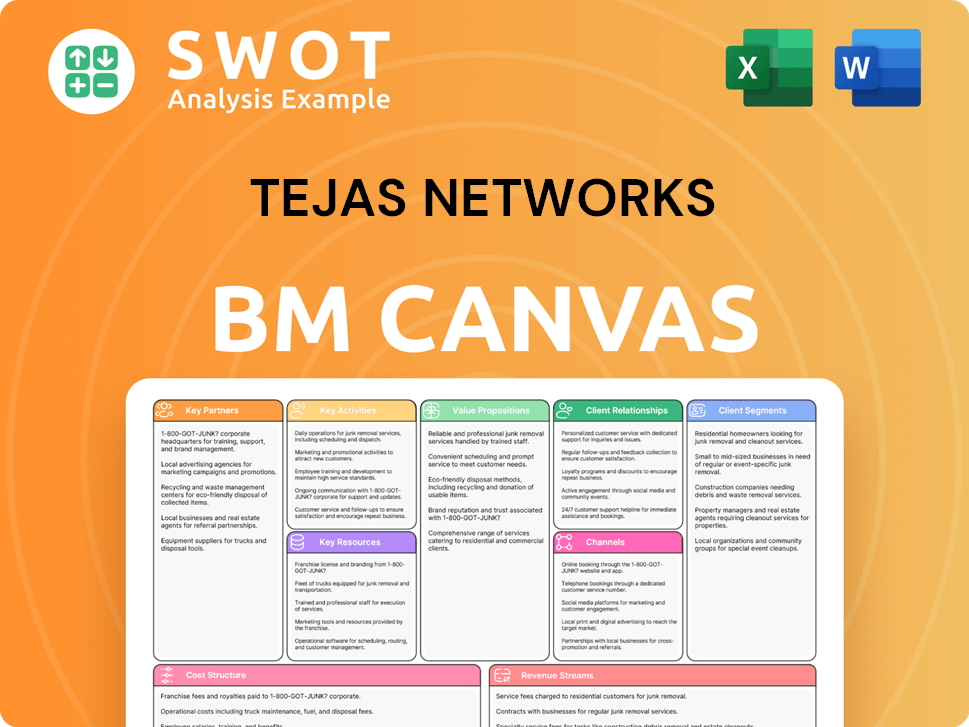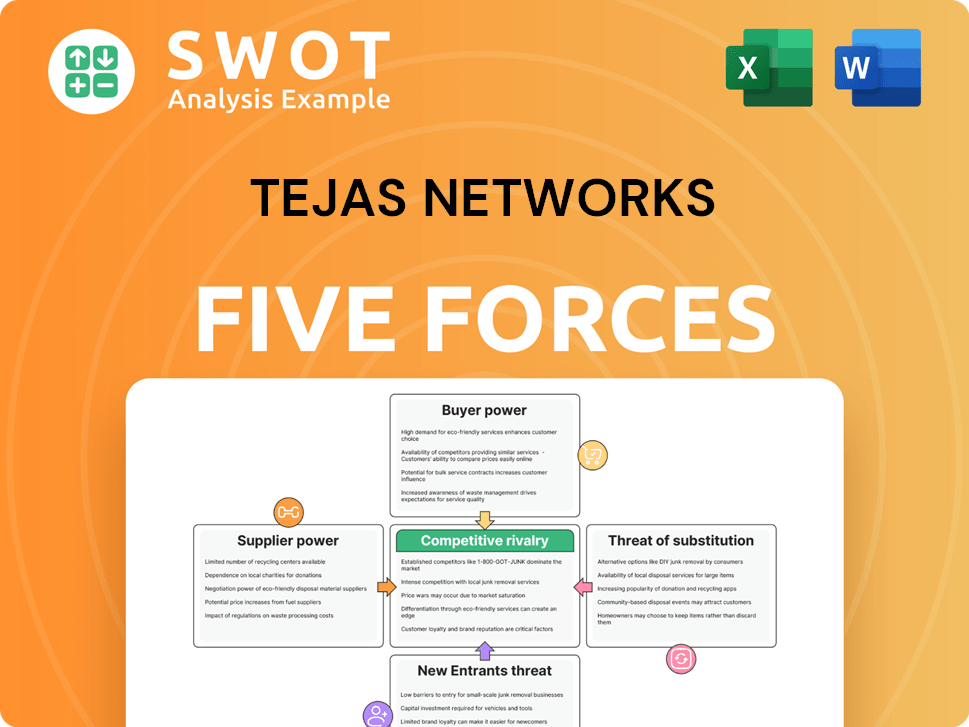Tejas Networks Bundle
Can Tejas Networks Conquer the Telecom Titans?
Founded in Bengaluru in 2000, Tejas Networks has become a significant player in the global optical and data networking products industry. From its humble beginnings, the company, backed by Tata Sons, has expanded its reach to over 75 countries, playing a crucial role in India's digital ambitions. But how does Tejas Networks stack up against industry giants in this fiercely competitive arena?

To understand Tejas Networks' position, we must explore its Tejas Networks SWOT Analysis, delving into the competitive landscape. This market analysis will identify key Tejas Networks competitors and evaluate their strengths and weaknesses. This analysis will provide valuable competitive intelligence, comparing Tejas Networks' financial performance against rivals like Nokia and Ericsson, and assessing its global market strategy within the optical networking market.
Where Does Tejas Networks’ Stand in the Current Market?
Tejas Networks has established itself as a significant player in the networking solutions sector, particularly within India and other emerging markets. The company's core operations revolve around providing a comprehensive suite of products, including optical networking, broadband access, and packet switching and routing solutions. These offerings are crucial for building and expanding communication infrastructure, facilitating high-speed data and voice transmission across various networks.
The value proposition of Tejas Networks lies in its ability to deliver end-to-end networking solutions. This includes optical transport, broadband access, and packet switching products, alongside wireless technologies, and network management solutions. This integrated approach allows the company to cater to a diverse customer base, including telecom service providers, internet service providers, government entities, defense, and utility companies, offering them the ability to build, expand, and modernize their networks efficiently.
The company serves a diverse customer base across more than 75 countries, demonstrating its global reach and adaptability to different market needs. This broad customer base includes telecom service providers, internet service providers, government entities, defense, and utility companies, highlighting the versatility and applicability of its products across various sectors.
Tejas Networks holds a strong position in the optical networking market, especially in India. The company's ability to offer a wide range of products, from optical transport to broadband access, positions it as a key player in the telecom equipment vendor landscape. This is supported by its strong financial performance and significant market share in key segments.
For the fiscal year ended March 31, 2025, Tejas Networks reported a substantial increase in revenue, more than tripling to ₹8,923 crore. The company turned profitable in 2024 and continued this momentum into 2025. The company's strong order book, which stood at ₹1,019 crore at the end of Q4 FY25, reflects its continued strong business momentum.
Tejas Networks offers a comprehensive product portfolio including optical networking products, broadband access products, and packet switching and routing products. This diverse range allows the company to cater to various networking needs. The company is also involved in wireless technologies and network management solutions.
Tejas Networks has a strong presence in India, being a sole supplier for major projects like BSNL's pan-India 4G/5G network. The company also operates in over 75 countries, indicating a global market strategy. The company's focus on emerging markets has contributed to its growth and market share.
Tejas Networks' competitive advantages include its strong position in the Indian market and its comprehensive product portfolio. Challenges include intense competition from established telecom equipment vendors and the need for continuous innovation. To further understand the market, consider reading about the Growth Strategy of Tejas Networks.
- Strong presence in the Indian market, being a sole supplier for major projects.
- Comprehensive product portfolio catering to various networking needs.
- Significant revenue growth, with revenue more than tripling in FY25.
- Challenges include competition from established vendors and the need for continuous innovation.
Tejas Networks SWOT Analysis
- Complete SWOT Breakdown
- Fully Customizable
- Editable in Excel & Word
- Professional Formatting
- Investor-Ready Format

Who Are the Main Competitors Challenging Tejas Networks?
The Tejas Networks competitive landscape is shaped by a global telecom equipment market that includes both established international giants and domestic players. Understanding Tejas Networks competitors is crucial for assessing its market position and growth potential. This Tejas Networks market analysis reveals a complex interplay of factors influencing competition.
The company faces challenges from various competitors who leverage different strategies. These strategies include scale, product portfolios, and technological advancements. The industry is also influenced by mergers, alliances, and emerging technologies.
The competitive dynamics within the optical networking market are intense, with several key players vying for market share. This section provides an overview of the major telecom equipment vendors competing with the company.
Major international players include Cisco, Huawei, Ericsson, Nokia-Siemens, Alcatel-Lucent, Ciena, and Adva. These companies often have a significant global presence and substantial resources. Huawei and Ericsson, for example, hold considerable market shares.
Additional competitors include Calix, Infinera, and Mavenir. These companies offer specialized products and services within the telecom equipment sector. They compete based on technology and market focus.
Domestic competitors in India include HFCL, STL, Tata Communications, Indus Towers, and Reliance Communications. These companies compete with the company in the Indian market, leveraging local market knowledge and relationships.
Competition is driven by factors such as price, innovation, branding, distribution networks, and technological advancements. Larger players often have advantages in scale and resources. Mergers and acquisitions also shape the competitive landscape.
Emerging players and technological disruptions continuously reshape the market. The industry is subject to rapid changes, requiring companies to innovate and adapt quickly. The Tejas Networks competitive landscape is dynamic.
Analyzing Tejas Networks market share analysis requires a careful examination of its position relative to its competitors. This includes assessing its strengths and weaknesses in comparison to rivals like Nokia and Ericsson. For a detailed look, consider reading this article on the company's performance in the market: Tejas Networks' performance.
The company faces several challenges in this competitive environment. These challenges include competition from larger, well-established global players, rapid technological changes, and the need to continuously innovate. Understanding these challenges is crucial for strategic planning.
- Scale and Resources: Larger competitors often possess greater financial and operational resources.
- Technological Advancement: Keeping pace with rapid technological changes and innovations.
- Market Dynamics: Adapting to emerging players and market disruptions.
- Price Competition: Managing price pressures in a competitive market.
Tejas Networks PESTLE Analysis
- Covers All 6 PESTLE Categories
- No Research Needed – Save Hours of Work
- Built by Experts, Trusted by Consultants
- Instant Download, Ready to Use
- 100% Editable, Fully Customizable

What Gives Tejas Networks a Competitive Edge Over Its Rivals?
Understanding the Tejas Networks competitive landscape involves recognizing its key strengths and strategic positioning within the optical networking market. The company has carved a niche for itself by focusing on indigenous technological development and strategic partnerships. This approach has allowed it to compete effectively against larger telecom equipment vendors. A deep dive into its competitive advantages reveals the factors that contribute to its resilience and growth potential.
Tejas Networks' market analysis indicates a strong emphasis on innovation, demonstrated by its extensive patent portfolio. Its ability to secure significant contracts, such as the BSNL 4G/5G network project, highlights its operational efficiency and customer trust. The company's growth strategy is further supported by its affiliation with the Tata Group and government initiatives, creating a favorable environment for expansion and market share gains. For a deeper understanding of their strategic approach, consider exploring the Growth Strategy of Tejas Networks.
The company's financial performance and market position are closely tied to its ability to navigate the challenges within the telecom sector. By examining its competitive advantages, we can better understand its ability to sustain growth and maintain a strong position in the market.
Tejas Networks' competitive advantages stem from its strong emphasis on research and development. The company has filed for over 445 global patents, with 267 already granted, which underscores its commitment to innovation. This focus allows them to offer high-performance and cost-effective solutions tailored for global markets, ensuring a competitive edge in the telecom equipment sector.
The strategic backing from the Tata Group provides financial stability and strategic direction. Furthermore, the company benefits from the 'Atmanirbhar Bharat' initiative and PLI schemes. For FY24, Tejas Networks received ₹123.5 crore under the PLI scheme, and it is eligible for ₹367.7 crore for 9M FY25, which supports its indigenous manufacturing capabilities and enhances its competitive positioning.
Tejas Networks has cultivated strong, long-term relationships with major clients across over 75 countries, including telecom service providers and government entities. Its success in securing major contracts, such as being the sole supplier for BSNL's pan-India 4G/5G network, highlights its strong execution capabilities and customer trust, which are crucial in the telecom equipment vendors landscape.
Strategic partnerships, such as the technology collaboration with NEC Corporation of Japan for advanced wireless technologies and RAN solutions, provide access to global customers and joint go-to-market opportunities. These collaborations strengthen its position in the global telecom market, enhancing its ability to compete effectively.
Tejas Networks' competitive advantages are multifaceted, combining technological innovation, strategic partnerships, and government support. These strengths enable the company to maintain a strong position in the optical networking market.
- Proprietary technologies and a strong R&D focus, evidenced by its patent portfolio.
- Strategic backing from the Tata Group, providing financial stability and strategic direction.
- Strong relationships with large clients and proven execution capabilities.
- Strategic partnerships expanding its global reach and market opportunities.
Tejas Networks Business Model Canvas
- Complete 9-Block Business Model Canvas
- Effortlessly Communicate Your Business Strategy
- Investor-Ready BMC Format
- 100% Editable and Customizable
- Clear and Structured Layout

What Industry Trends Are Reshaping Tejas Networks’s Competitive Landscape?
The telecommunications industry is undergoing significant changes, driven by the global rollout of 5G, the need for fiber broadband, and the emergence of AI-driven networking. This creates both opportunities and challenges for companies like Tejas Networks. A thorough Tejas Networks competitive landscape assessment is essential for understanding its position in this dynamic market.
The company faces intense competition from established players such as Cisco, Huawei, and Ericsson. Additionally, execution risks, currency fluctuations, and the need for continuous R&D investments pose challenges. Despite these hurdles, the Tejas Networks market analysis reveals strong domestic opportunities and the potential for international expansion, supported by strategic partnerships.
The optical networking market is growing due to the increasing demand for high-speed data transmission. 5G network deployments and fiber broadband expansion are key drivers. AI-driven networking and automation are also transforming the telecom sector, creating new opportunities for innovation.
Intense competition from established telecom equipment vendors like Cisco and Ericsson remains a significant challenge. Currency volatility and execution risks, such as delays in product delivery, could impact margins. Rapid technological advancements require constant R&D investments to stay competitive.
Domestic opportunities are robust, with government projects and private sector initiatives driving demand. International expansion, especially in the Americas, EMEA, and ANZ regions, offers significant growth potential. Strategic partnerships, like the one with NEC Corporation, can provide access to global markets and enhance competitiveness.
Focusing on private 5G solutions, high-speed fiber upgrades, and AI-driven networking aligns with market demands. The company's product portfolio expansion and market diversification strategies are crucial. Strategic collaborations will be essential for achieving stronger growth in FY26, as highlighted in the Owners & Shareholders of Tejas Networks article.
The Tejas Networks competitive landscape is characterized by both challenges and opportunities. The company's ability to navigate these factors will determine its future success.
- The company's focus on 5G, fiber, and AI-driven networking is strategically sound.
- Competition from established players like Huawei and Ericsson remains a threat.
- Strategic partnerships and international expansion efforts are crucial for growth.
- Financial performance in FY25, including the net loss in Q4, reflects the need for improved profitability and efficient cash flow management.
Tejas Networks Porter's Five Forces Analysis
- Covers All 5 Competitive Forces in Detail
- Structured for Consultants, Students, and Founders
- 100% Editable in Microsoft Word & Excel
- Instant Digital Download – Use Immediately
- Compatible with Mac & PC – Fully Unlocked

Related Blogs
- What are Mission Vision & Core Values of Tejas Networks Company?
- What is Growth Strategy and Future Prospects of Tejas Networks Company?
- How Does Tejas Networks Company Work?
- What is Sales and Marketing Strategy of Tejas Networks Company?
- What is Brief History of Tejas Networks Company?
- Who Owns Tejas Networks Company?
- What is Customer Demographics and Target Market of Tejas Networks Company?
Disclaimer
All information, articles, and product details provided on this website are for general informational and educational purposes only. We do not claim any ownership over, nor do we intend to infringe upon, any trademarks, copyrights, logos, brand names, or other intellectual property mentioned or depicted on this site. Such intellectual property remains the property of its respective owners, and any references here are made solely for identification or informational purposes, without implying any affiliation, endorsement, or partnership.
We make no representations or warranties, express or implied, regarding the accuracy, completeness, or suitability of any content or products presented. Nothing on this website should be construed as legal, tax, investment, financial, medical, or other professional advice. In addition, no part of this site—including articles or product references—constitutes a solicitation, recommendation, endorsement, advertisement, or offer to buy or sell any securities, franchises, or other financial instruments, particularly in jurisdictions where such activity would be unlawful.
All content is of a general nature and may not address the specific circumstances of any individual or entity. It is not a substitute for professional advice or services. Any actions you take based on the information provided here are strictly at your own risk. You accept full responsibility for any decisions or outcomes arising from your use of this website and agree to release us from any liability in connection with your use of, or reliance upon, the content or products found herein.